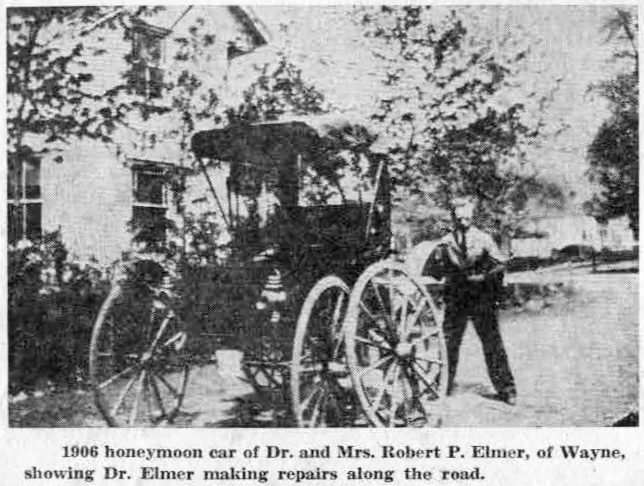What was it like to go on a honeymoon trip by automobile in 1906? In particular, what was it like to go from Philadelphia to the Catskill mountains in early May of that year, in a chain driven Horsman automobile? The groom had to stop every few miles to repair broken links of the chain, while his bride sat on the porch of a nearby house, on a conveniently located fence, or on the grass along the road.
During the past week, the story of just such a honeymoon was told your columnist by Mrs. Elmer, widow of Dr. Robert P. Ebner, for many years one of Wayne’s best known physicians. Dr. Elmer died on March 4, 1951, after 47 years of continuous medical practice in Wayne and vicinity.
 When Dr. Elmer, a native of Bridgeton, N.J., came to Wayne in 1904, he bought the house just opposite the Wayne Methodist Church. One of the Wayne Estate houses built in the 1880’s, it looked then very much as it does today, except for a large addition on the west side of the house.
When Dr. Elmer, a native of Bridgeton, N.J., came to Wayne in 1904, he bought the house just opposite the Wayne Methodist Church. One of the Wayne Estate houses built in the 1880’s, it looked then very much as it does today, except for a large addition on the west side of the house.
Here Dr. Elmer established his practice in 1904 in the office he was still maintaining at the time of his death. Beginning with his great-great-grandfather, Dr. Jonathan Elmer, he represented the last of the longest line of physicians in the United States.
When Dr. Elmer first started his round of visits to patients in 1904, he drove “a little Oldsmobile car that would not go up any hill, but had to be pushed and pulled,” according to Mrs. Elmer, who adds, “and then the Doctor read that a Horsman car would climb any hill.” That first Oldsmobile had been a one-seated car without a top, “a very nice looking car” as Mrs. Elmer remembers it. The Horsman, which looked “like a buggy,” as the accompanying picture very plainly shows, was made in the mid-west, one of the earlier American cars to appear on the market.
Imagine the May day, on which the Elmers started on their honeymoon. Roads were narrow and rough, or of the “corduroy” variety. Once they had to cross a small stream, by way of a bridge which was drawn back and forth across the water. In spite of the fact that the bridge had a railing on each side, Mrs. Elmer was fearful every moment of a sudden plunge overboard.
Although they encountered many horse drawn vehicles along the way, Mrs. Elmer does not remember passing even one other automobile during the entire trip. She does recall, vividly, the encounters with wagons and buggies, as every horse had to be led past the Horsman, with most of them rearing wildly on their hind legs to the accompaniment of loud voiced comments on the part or their drivers, who definitely did not like “them new fangled contraptions.”
During the week that it took to reach the section of the Catskills around which many of the happy memories of Dr. Ebner’s youth centered, the young couple had many pleasant and amusing experiences. Once, while Mrs. Elmer was sitting cozily back in the car with all the curtains drawn because of the rain, two farmers came out of the store into which Dr. Elmer had gone for a can of gasoline. (There were, of course, no gasoline stations in those days.) The farmers examined every detail of this strange conveyance, not noticing Mrs. Elmer behind the curtains. Finally, one said, “But whar’s the hoss?’’ And then as they reached the rear of this vehicle without its “hoss,” they saw the license plate bearing the numerals 1776. They broke into loud guffaws of laughter, and one farmer exclaimed, “Why, this here buggy must have been built in 1776!”
In the spring of 1904 some of the small hotels were open even in May – “many of them quaint and always comfortable,” according to Mrs. Elmer. And Dr. Elmer, who had spent much time in the Catskills, knew the location of these small hostelries and tea houses and various other eating places where good food could be obtained.
And so that May-time honeymoon of 49 years ago, taken in the buggy-like automobile, had a charm all its own, far exceeding any of this May of 1955. The narrow, tree-shaded roads that the Elmers travelled then have become broad and noisy automobile highways, lined with gasoline stations and hot dog stands.
